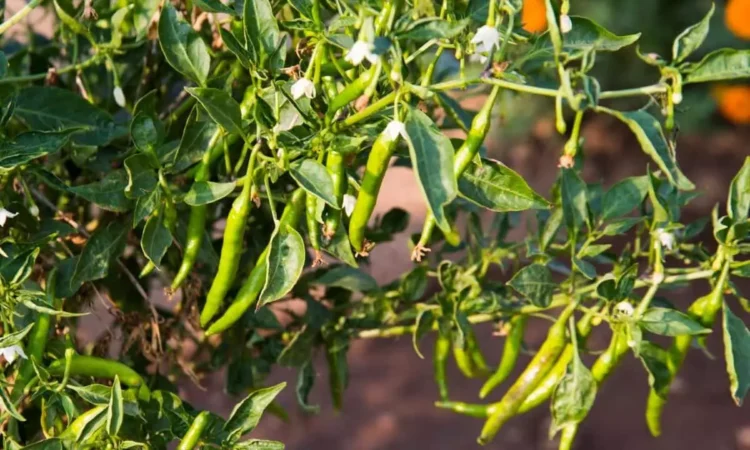Chilli, once a prominent cash crop in India, has experienced a decline in cultivation across major growing regions. Contributing nearly one-third of global chilli production and accounting for 30 percent of India’s spice exports, the chilli crop is crucial to the nation’s economy and food culture. However, this dominance is increasingly threatened by unseasonal rains and pest pressures. Climate change, driven by global warming, is worsening the frequency and severity of pest infestations, leaving farmers vulnerable to severe yield losses. Pest issues in chilli crops can lead to reductions in yields by 20-50 percent, with more severe outbreaks causing losses of 60-90 percent.
The economic repercussions for farmers are significant, as illustrated in 2021 when a black thrips outbreak in key states like Andhra Pradesh, Telangana, and Karnataka resulted in estimated losses ranging from INR 3,000 to 5,000 crore. Given these high stakes, a scientific, multi-faceted approach to pest management has become imperative for protecting crop productivity and farmer livelihoods. The first critical step in this pest management battle is scouting. In Kharif 2023, more than 90% of chilli growers reported pest attacks during the 50-130 days after transplanting (DAT) period. Therefore, scouting is foundational to a successful pest management strategy, acting as the primary defense against pest invasions.
Since chilli plants are susceptible to pests throughout their lifecycle, consistent monitoring is vital from seedling to harvest. Early detection through scouting facilitates timely interventions, enabling targeted and sustainable pest control measures. Traditional pest control methods often rely heavily on uncontrolled pesticide use, with farmers applying substances without scientific guidance regarding types or quantities. This approach aims to eradicate pests but can inadvertently harm soil health and lower yields. Such dependence on pesticides not only damages ecosystems but also undermines the long-term viability of chilli farming. In contrast, scouting empowers farmers to identify early signs of pests, diseases, or stress factors, allowing them to make informed decisions about pesticide applications.
Scouting also promotes precision, enabling farmers to target harmful pests while preserving beneficial insects that are essential to crop ecosystems. The Food and Agriculture Organization (FAO) indicates that early pest detection can decrease crop losses by up to 40 percent, highlighting scouting’s crucial role in minimizing damage and ensuring productivity. Effective scouting demands skilled observation, prompting many agricultural communities to prioritize education and training programs to help farmers accurately recognize early warning signs of pest activity. Technological advancements have transformed the scouting process, leading to more efficient monitoring practices. Innovations such as GPS imaging and drones have revolutionized field observations, providing real-time surveillance across large areas.
Satellite imaging enhances the capacity to detect and analyze pest presence at a broader level, creating a detailed, data-driven overview of the health of chilli fields and pest conditions. Early detection facilitated by these technologies enables rapid containment of pest issues, reducing the spread of infestations and the need for excessive pesticide use. Such advancements allow farmers to transition from traditional scouting techniques to more sophisticated, precision-focused methods. For instance, drone surveillance provides high-resolution imagery that can identify pest hotspots, while thermal imaging detects plants under stress due to pests, highlighting affected areas before visible damage occurs. These technologies equip farmers to better safeguard their crops, lower input costs, and sustainably improve crop yield quality.
While scouting is critical, its effectiveness is significantly enhanced when it is part of a comprehensive Integrated Pest Management (IPM) framework, which employs multiple strategies to keep pest populations below damaging levels. Scouting is a core component of this framework, enabling precise monitoring and assessment of pest levels. Cultural practices are fundamental to IPM, as they mitigate pest risks by modifying the farming environment. For example, crop rotation disrupts pest life cycles by introducing diverse, non-susceptible plants, thereby diminishing pest population persistence. Field sanitation—removing plant debris and organic matter—also plays a vital role by eliminating potential breeding grounds for pests. Additionally, irrigation strategies help manage humidity levels, which can make chilli crops less vulnerable to pest outbreaks.
Although chemical control remains a key aspect of pest management, scouting plays a pivotal role in guiding farmers to apply pesticides judiciously and only where needed. By using precise amounts when necessary, chemical interventions minimize harm to beneficial insects and mitigate negative impacts on soil health, thus protecting the environment while maintaining effective pest control. Together, these techniques promote a balanced and sustainable approach to pest management, with scouting serving as the central guiding tool. By integrating cultural, biological, and chemical strategies within a cohesive IPM framework, farmers can confidently protect their chilli crops, achieve reliable yields, and maintain environmental health.
Building upon the foundations of scouting and IPM, the implementation of advanced crop protection solutions has further bolstered chilli farmers’ resilience. These innovative technologies are specifically designed for targeted control of thrips and mites, two of the most harmful pests affecting chilli cultivation. Unlike traditional broad-spectrum pesticides, these solutions provide high efficacy while ensuring crop safety, effectively reducing pest pressure without compromising plant health and vigor. Their novel chemistry and unique modes of action also minimize the risk of resistance development, offering long-term protection for farmers. Additionally, their compatibility with IPM programs and their ability to protect beneficial insects make them an attractive option for sustainable chilli farming.
By integrating these innovations with scouting and other cultural practices, farmers can significantly boost productivity while lessening their environmental footprint. As Indian chilli farmers confront an increasingly complex pest landscape, investing in scouting as a pest management technique has shifted from an option to a necessity. Scouting provides a proactive, data-driven foundation for pest management, facilitating early detection essential for avoiding costly losses. By merging scouting with other IPM strategies, including cultural and biological controls, India’s chilli growers can mitigate pest risks, sustain high-quality yields, and safeguard their economic well-being.
